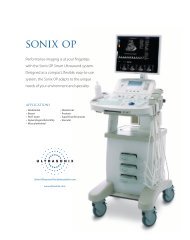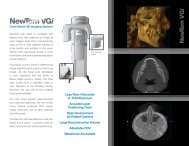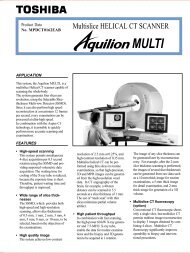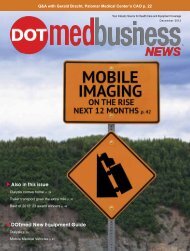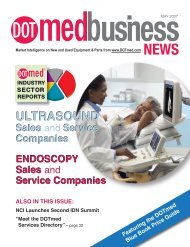I S S U E - DOTmed.com
I S S U E - DOTmed.com
I S S U E - DOTmed.com
You also want an ePaper? Increase the reach of your titles
YUMPU automatically turns print PDFs into web optimized ePapers that Google loves.
A Look at Usage for Pets<br />
form services they have the knowledge<br />
to do,” explained Dr. Fisher.<br />
According to Dr. Fisher, the particular<br />
skill sets of each veterinary school<br />
graduating class impacts the supply and<br />
demand of vet equipment sales. “Ultrasound<br />
requires advanced training — it is<br />
very sophisticated equipment that needs<br />
to be in the hands of well-trained and<br />
board-certified doctors,” he noted.<br />
“Independent veterinarians who<br />
work outside of the VCA hospital network<br />
are looking for equipment they<br />
[already] know how to use or is easy to<br />
be trained on, performs well and is easy<br />
to care for,” he observed. In terms of<br />
usage, “a CT is a CT and a MRI is a<br />
MRI,” and such pieces easily adapt to<br />
both human and animal medical diagnostic<br />
needs. In ultrasound, for example,<br />
there are “plenty of pediatric probes<br />
that work really well on animals.”<br />
But there are certain equipment<br />
parts not so easily transferrable from<br />
human to animal applications. “One<br />
<strong>com</strong>pany created a waterproof PET<br />
transmitter for vet use because they saw<br />
the need for it,” said Dr. Fisher, explaining<br />
that in human PET scanners, the<br />
transmitters are not waterproof.<br />
“If there is a real need for vet equipment,<br />
it will be produced. If there’s a<br />
market for it, it gets developed,” Dr.<br />
Fisher noted.<br />
“When veterinarians choose a piece<br />
of equipment, they’ll want to find the best<br />
equipment for that indication: sometimes<br />
it’s used or new. Sometimes, a new treatment<br />
may not be as good as the old one<br />
— and many times the used [equipment]<br />
better fits our needs,” he said.<br />
As for future veterinary equipment<br />
sales, Dr. Fisher sees the market in “imaging<br />
of all kinds — including ultrasound,<br />
digital X-ray, CT, and MRI, for<br />
both new and used equipment.”<br />
OEMs, such as Universal Ultrasound<br />
in Bedford Hills, NY, and Wolf<br />
X-Ray Corporation in Deer Park, NY,<br />
believe that this will be part of the vet<br />
market trend.<br />
“Digital radiography, PACS systems<br />
and teleradiography” are among<br />
the sellers in new vet equipment sales,<br />
wrote Rebecca Owens, RTR, a digital<br />
radiology sales specialist at Universal<br />
Ultrasound.<br />
“In used vet equipment sales, ultrasound<br />
equipment is a popular seller,”<br />
Ms. Owens noted. The <strong>com</strong>pany sells<br />
new ultrasound equipment from $4,000<br />
to $125,000 and digital radiography<br />
equipment from $40,000 to $100,000.<br />
Universal Ultrasounds markets to small<br />
and large animal practices.<br />
“In the vet market, I see diagnostic<br />
imaging as a growth segment,” said<br />
Howard Wolf, president of Wolf X-Ray<br />
Corporation, an 80-year-old family-run<br />
veterinary radiography firm. “Considering<br />
the current malaise of the country,<br />
it will take 12 to 18 months for [this<br />
market] to grow,” he said. His firm is<br />
best known for selling vet radiography,<br />
lead protection and film viewing equipment<br />
— about 80% of his business is<br />
currently in analog form.<br />
There will be “an increase in [demand]<br />
for digital and ultrasound equipment<br />
as they be<strong>com</strong>e more popular,”<br />
Mr. Wolf said. Wolf X-Ray Corp. has<br />
its own R & D unit, which has “developed<br />
a line of conductivity gels, e.g.,<br />
one that can be used on animals to obtain<br />
images through the fur” — this will<br />
be presented at the North American Veterinary<br />
Conference (NAVC) in January.<br />
Wolf X-Ray Corp. sells to university<br />
medical hospitals, private vet practices<br />
and veterinary schools. “On the<br />
East and West coasts, they are far more<br />
progressive in the medical fields,” Mr.<br />
By Regina Geok-Ling Tan<br />
Wolf observed. “A lot of the coastalbased<br />
veterinarians are [converting] to<br />
electronic health records (EHR). The<br />
Midwest is probably 25% less active in<br />
digital [recording].”<br />
On a cost-<strong>com</strong>parison basis for using<br />
EHR, Mr. Wolf said, “[for] a 5-practitioner<br />
facility, it would cost $180,000<br />
to initially set up a digital X-ray system…<br />
if you’re 35 and just starting a<br />
practice and you want to do it right, it’s<br />
probably okay to do it, but, if you’re in<br />
your 50’s and planning on retiring in<br />
five years, you’re better off buying another<br />
machine for five grand.”<br />
“If I was going to give a doctor<br />
advice, I would say, ‘Find a local, fullservice<br />
distributor who is familiar with<br />
a top brand.’ A good, local distributor<br />
gives you assurance of having a good<br />
service contract and maintenance. I’m<br />
a big believer in having a local guy take<br />
care of you,” emphasized Mr. Wolf.<br />
“Diagnostic manufacturers seem to<br />
be doing well,” said Mark Ziller, president<br />
of TW Medical, an ISO in Lago<br />
Vista, TX. And, “Digital X-ray is just<br />
on the upswing, with dental diagnostics<br />
also being a growing segment.”<br />
“Frequently, we deal with veterinarians<br />
that are opening a new<br />
business,” said Mr. Ziller. “On-going<br />
customers will need upgrades and replacements.<br />
We can <strong>com</strong>pletely outfit<br />
a new practice, e.g., autoclaves, surgery<br />
lights, exam and surgery tables, cages,<br />
anesthesia machines, surgical monitoring<br />
equipment, lab equipment, digital<br />
X-rays, CT’s, and MRI’s.”<br />
Among the OEM’s used for TM<br />
Medical’s offerings are Abaxis, Heska,<br />
and Midmark — “representative <strong>com</strong>panies<br />
that cover an important market<br />
segment,” according to Miller.<br />
Mr. Ziller has been in the animal<br />
health industry for 15 years. TW Medi-<br />
<strong>DOTmed</strong>business news I s e p t e m b e r 2009 47




